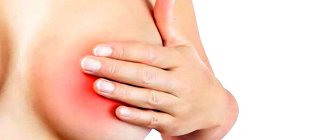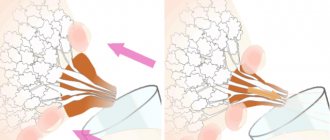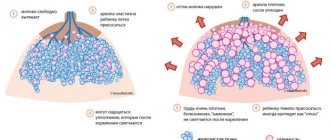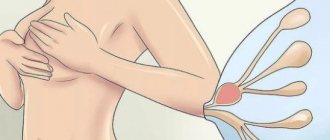11/27/201602/16/2017 Nadezhda Plotnikova 2 comments
Few breastfeeding women have avoided such an unpleasant condition as lactostasis. This term refers to stagnation of milk, manifested by painful sensations, thickened areas and redness of the skin of the mammary gland.
The main danger of such a phenomenon is the possibility of its development into a more serious problem - inflammation of the mammary glands. And in such a situation, treatment with medications and even surgery cannot be ruled out. That’s why it doesn’t hurt to know how lactostasis manifests itself in a nursing mother and how to cure it at home.
Reasons for stagnation
The beginning of treatment for any disease is preceded by the identification and elimination of the causes that caused it, therefore, before starting to study all the ways to express milk during stagnation, you need to familiarize yourself with the causes of its occurrence.
So this is:
- blockage of the ducts, which can cause cracked nipples;
- incorrectly selected bra;
- chest injuries;
- feeding regimen with long breaks;
- monotonous feeding position or repeated pumping technique, as a result of which not all areas of the breast are emptied;
- lying on your side for a long time or an uncomfortable position while sleeping;
- introduction of complementary foods (the amount of milk sucked by the baby decreases).
How is the disease diagnosed?
Lactostasis is difficult to distinguish from the aseptic form of mastitis in the initial phase: the similarity of external signs, the irrelevance of clinical tests before the development of purulent mastitis.
Informative methods to determine non-inflammatory stagnation of milk from mastitis:
- ultrasonography;
- bacterial culture of breast milk;
- puncture of the chest to obtain samples from lumps.
A comprehensive examination using the above methods will give an answer about the nature of the disease and means for treating lumps in the mammary glands.
Symptoms
Lactostasis is accompanied by the following symptoms:
- breast swelling;
- pain during feeding or pumping;
- the breast becomes dense, when palpated, compactions in the form of one or several lobules are detected;
- increased body temperature;
- redness of the skin of the chest;
- uneven milk release.
Expressing your breasts is not a very pleasant procedure, but despite the pain, you need to be patient and strong and proceed with it. Prolonged lactostasis or critically high temperature is a reason for urgent consultation with a specialist. If no action is taken, the problem will lead to extremely unpleasant situations.
Using compresses
For clear and painful lumps in the mammary gland, compresses will help to dissolve the “plug”. Warm pads relax the pectoral muscles and improve milk flow, while cold pads perfectly relieve swelling.
The simplest but most effective procedure is to wet a napkin in warm water and apply it to the hardened area. It is necessary to make such a compress before feeding or expressing milk. If body temperature is high, warm pads are canceled.
However, elevated temperature is not an absolute contraindication for applying compresses. Experts in breastfeeding recommend treating lactostasis using the following overlays:
- Cabbage compress. The cabbage leaf is washed, beaten until juice appears and applied to the compacted portion. As soon as the leaf dries out, it is replaced with a fresh one.
- Curd compress. A cool cake is made from fresh cottage cheese, which must be applied to the problem area for a quarter of an hour.
- Honey-flour compress. Honey and flour are mixed until a homogeneous mass is placed on a plastic bag and “put” on the chest. Keep this pad on for about 30 minutes.
For breastfeeding mothers, a cold compress is also useful, which is effective for severe swelling.
It is extremely simple to do - just apply a cold cloth for a couple of minutes after pumping or feeding the baby. There is no need to apply compresses soaked in alcohol or camphor to the chest. These substances block the release of oxytocin, as a result of which the milk flow only worsens, and the swelling of the mammary glands only intensifies.
Preparing for decanting
You need to familiarize yourself with ways to strain milk stagnation at home. Complete emptying of all areas of the breast will prevent the occurrence of purulent processes and will ensure continuous and normal breastfeeding.
All young mothers who notice the first signs of lactostasis are recommended to follow a certain action plan. So, before you strain lactostasis, you should properly prepare your breasts. There are the following methods for this.
Warming up
Heat dilates the milk ducts and promotes normal milk flow, so before you relieve stagnant milk at home, you can stand in a warm shower.
A cabbage leaf with honey applied to the painful area also helps relieve pain and swelling. The sheet is applied for no more than 15 minutes.
Physiotherapy
Special procedures carried out in the physiotherapy room will have a beneficial effect on the further neutralization of lactostasis; experienced specialists will tell you how to break up the lumps. Among the wide variety, you may prefer ultrasound or UHF therapy.
Massage
You will learn how to massage the mammary glands during milk stagnation in our video at the end of the article. Very simple manipulations, carried out with careful light movements, contribute to the easy outflow of milk.
Folk recipes
Many young mothers do not know how to get rid of lactostasis using time-tested methods. Often, compresses made from:
- cabbage;
- honey;
- magnesia;
- potatoes and other ingredients.
Compresses help cope with the main signs of pathology without harm to the woman and baby
It is important to obtain the approval of your doctor before treating lactose stasis at home. Let's look at the most popular recipes
Cabbage leaf
The vegetable effectively copes with pain that occurs in the chest area. To do this, you need to take a leaf from the middle of the head of cabbage, wash it and lightly beat it with a wooden hammer in the concave part until the juice begins to release. Next, the sheet is applied to the chest and secured with a bandage. After 3-4 hours, the cabbage leaf should be replaced. Regular use helps relieve not only pain, but also swelling.
Camomile tea
In folk medicine, chamomile is widely used; the flower also helps with lactostosis. To prepare the decoction you will need 20 g of plant material, which is poured with 200 g of boiling water. The composition is aged for 1 hour. Next, a small piece of cloth or gauze is soaked in the broth and applied to the painful area. After 10-15 minutes, the compress is removed. The procedure is repeated three times a day.
Honey and onion cake
You can get rid of lactostasis using a dough cake with the addition of honey and onions.
- A medium-sized onion should be peeled and then chopped using a grater or blender.
- Add 1 tbsp to the container. l. honey
- The mixture is thoroughly mixed.
- Next, flour is added to it until a dough with an elastic consistency is obtained. It is better to use rye flour for medicinal purposes.
- The finished dough is rolled out into a flat cake, which is then applied to the chest and secured with a bandage.
It is recommended to do the procedure in the evenings in anticipation of a night's rest. The cake should be removed in the morning. You should use this recipe until the seals are completely eliminated.
Potato cake
A medium-sized potato must be peeled, grated on a fine grater, the resulting pulp spread on a piece of cloth and applied to the mammary glands. The flatbread, which relieves discomfort, pain and swelling, stays on the chest for at least 1.5 hours.
Magnesia compress
The product has a powerful absorbing effect. To prepare the compress you will need powder or 2-3 ampoules of magnesia, which are diluted with water. Gauze or fabric is soaked in the resulting composition. The compress is applied to the painful area, but so that the areola and nipple are not affected. Apply a dry, clean cloth to the gauze, then cling film. After this, wear only loose underwear. The procedure is carried out immediately after feeding the baby. The compress is removed after the fabric has completely dried. Before use, consult a specialist to avoid a possible allergic reaction.
Compress with camphor oil
Some doctors recommend camphor oil for lactostasis. To do this, camphor is applied to a small piece of gauze or cloth and then applied to the chest. There is cellophane on top, which is secured with a bandage. The camphor oil compress should be kept for at least 6-8 hours.
Compresses using alcohol
Before using any alcohol-containing products to treat the mammary glands, it is important to make sure that you have lactostasis and not mastitis. The latter completely excludes the use of any heating techniques, since they contribute to the spread of the purulent process
For preparation, vodka or alcohol is used, diluted with water in a ratio of 1:2. This will help avoid skin burns. A piece of gauze or bandage must be soaked in liquid and applied to the seal. The compress is covered with cling film and secured with a bandage. Removed after 2-3 hours. It is not recommended to repeat the procedure more than once a day. Do it immediately after feeding the baby.
Treatment of lactostasis at home can be carried out in various ways. Proper prevention of congestive processes is of great importance for the health of a young mother. Feed your baby regularly, make sure your breasts are completely emptied, and avoid hypothermia and physical and mental overload.
Decantation technique
A special technique developed for nursing mothers will successfully remove stagnation of breast milk. Due to the pain of the procedure, preliminary preparation is required. The psychological attitude of a woman is also important; she must understand that if nothing is done, then the outcome will be disastrous. The massage is carried out in such a way as not to damage the breasts. All movements must be neat, smooth and soft. Squeezing, excessive pressure and the use of physical force are highly discouraged. You can learn how to massage your breasts during milk stagnation from the video in our article.
The massage is carried out in three stages:
- Before kneading milk stagnation, you need to sit comfortably and relax, think about something good. Four fingers of one hand are located under the breast, the index and thumb converge in the area near the nipple, that is, they come as close as possible to the areola. The other hand is placed on top of the chest. Next, apply rhythmic pressure with light movements of the palms, trying to move from the periphery to the center. We pay attention to the milky sinuses, which are easily palpable during lactostasis; this is an effective way to strain the thoracic ducts.
- Only light and soft movements of the fingers and hands will help to resolve lactostasis, otherwise (with the help of sharp, strong pressure) you can only aggravate the situation - this must always be remembered. The position of the hand is under the breast, the thumb and forefinger are closed near the nipple. Using pressing movements, we move towards the center, and try to cover the entire chest space. If the discharge from the nipples has stopped, we massage the breasts to increase lactation at the same pace.
- We perform light tapping and stroking from the peripheral zone to the center and continue to take steps to strain stagnant milk with our hands.
Is a breast pump necessary for a nursing mother?
You need to learn how to express by hand, because your hands are the best and most reliable tool; they cannot be replaced by a breast pump. But there are modern accessories that help you do this quickly and efficiently if necessary. A breast pump will help if milk stasis has already occurred.
Breast pumps for lactostasis are divided into 2 large groups.
A). Mechanical
Which in turn are divided into:
- Lactators - long flasks, pears. They will help mom get rid of excess milk. But they will not help if lactostasis has already occurred
- Actually, breast pumps - with a piston handle - will help both get rid of excess milk and eliminate lactostasis
b). Electronic
What to look for when choosing a breast pump. If we are talking about mechanical, then there must be a handle
Make sure it creates a good vacuum. And there must be a silicone nozzle (both petal and flat), but its main functions are to create a tight attachment and hold the vacuum even after the milk has started
If we are talking about mechanical, then there must be a handle. Make sure it creates a good vacuum. And there must be a silicone nozzle (both petal and flat), but its main functions are to create a tight attachment and maintain a vacuum even after the milk has flowed.
They can be single-phase, when the mother herself regulates the frequency of pressing, and two-phase, which first stimulates the milk and then expresses it.
Place the breast pump in the center. The nipple should go exactly in the center, it should not rub, so as not to create cracks and injuries to the nipple. The pumping process itself should not cause discomfort. If the nipple is large, then there are additional attachments for large breasts.
An important point is that when pumping, the mother should relax, think about her baby (put the baby near her, or a photo of him if the baby is not nearby), because when the mother thinks about her baby, the oxytocin reflex is triggered and the milk begins to flow more actively, and pumping is more efficient.
Before expressing, it is better to warm the breasts - this can be a warm, damp towel, a diaper with warm water, a thermal nozzle (it becomes warm when heated), and you need to apply it to the breast. When a mother uses a warm shower, it not only warms the breasts, but also massages them.
3. Cabbage leaf for lactostasis
WHO (World Health Organization) recommends using cabbage leaves AFTER the cessation of lactostasis and the opening of the lobule. In this case, like a cooling compress, it helps relieve swelling and brings relief to the mother.
4. Alcohol compress
Again, according to WHO recommendations, in no case should alcohol compresses be used during lactostasis. Because alcohol interferes with milk flow and is absorbed into breast milk.
5. Physiotherapy
Ultrasound effectively resolves milk stasis. Oxytocin contracts the milk ducts and helps improve milk flow. But these procedures are used as prescribed by a doctor.
6. Breast massage for lactostasis
Before you start massaging the mammary gland, you need to warm it up by applying a warm, damp towel. Massage movements should be gentle so as not to damage the milk ducts filled with milk.
A short video on how to massage the mammary glands
Duration of treatment
The duration of one procedure should not be less than 20 minutes. It is very important to start treatment in the early stages, then the effect will be noticeable within a day. If a woman does not know how to properly knead the mammary glands during feeding, and time is lost, then progress will be noticeable only after 3 days. Lastly, the redness subsides.
In the future, it is recommended to put the baby to the breast quite often, this way you can avoid the appearance of these unpleasant symptoms.
Useful tips
Before straining stagnant milk, you need to carry out proper preparation. Only in this case can one hope for effectiveness and obtaining a good result from the manipulations. There are some recommendations that will improve and facilitate the process.
Warming
You can warm up your breasts with a small heating pad or a warm diaper. It is very important to ensure that the water is warm and not hot.
It is necessary to refuse warming up if a woman has a temperature that is even slightly higher than normal. It is better to wait until it returns to normal, then proceed with further steps to strain stagnant milk at home.
ethnoscience
A cabbage leaf poultice is a great preparatory step before straining the breast. Before applying, the leaf is beaten until the juice is released. If you are not allergic to honey, you can apply a thin layer of honey to the inside of the leaf. This product will not only warm up the breasts, but also make the skin softer and silkier.
Doctors very often recommend this effective method to their patients, as it relieves pain and swelling. Also for this purpose, cakes made from flour and honey are used; if possible, you can apply low-fat cottage cheese to the chest.
Communication with a specialist
The extensive practice of specialists in this field will allow you to choose the most effective way to strain breast milk. They may recommend physical therapy as a preparatory procedure.
In any case, only a specialist will give valuable advice for each individual case, tell you what to avoid and how to properly strain milk stagnation for those women who have never undergone such procedures.
Changing your baby's position when feeding
At the first sensation of pain or the appearance of lumps, you should change your position when feeding, this is what determines the uniform emptying of the breast. Lumps in the middle of the chest will disappear if you feed the baby while lying on your side, not with the breast that is lower, but with the one that is further from the baby.
If stagnation has formed on the side of the armpit, feeding should be done from under the arm. If the lower part of the chest is full, the child is placed facing the chest, in a sitting position, the upper part is placed on the back with his legs away from the mother, and she bends over him. In general, your baby's chin should point towards the area where the congestion has formed.
If you follow these recommendations, you can forever forget about the signs of lactostasis and how to break up a lump when milk stagnates.
Frequent feeding
In order not to have to worry about how to express breast milk with your hands during stagnation, you need to feed your baby often, but in small portions. Such feeding will have a beneficial effect on the health of mother and baby.
Other ways to get rid of lactostasis
Nursing mothers can combine treatment at home using unconventional means with the use of pharmaceuticals. Ointments and medicinal infusions that are allowed during breastfeeding will be useful.
Before using them, it is better to consult a doctor who will tell you how to treat lactostasis correctly. It is permissible to use the following means:
- Arnica cream. Used to reduce the severity of pain in nursing mothers. Apply the product to compacted areas several times a day between feedings.
- Elixir Malavit. The tincture is diluted with water (in a ratio of 1 to 1), a cotton swab is moistened and applied to the hardened area. You need to hold the compress until the next feeding of the baby.
Treatment of lactostasis in women with medical products intended to get rid of edema and hematomas is prohibited! The specifics of their influence on the child’s body during breastfeeding have not been established.
If pain intensifies or hardness in the breast persists, the best option for nursing mothers is to consult a doctor. In such situations, physiotherapy is prescribed, which is carried out outside the home, but effectively breaks up milk stagnation.
- Ultrasound procedures. They will help you get rid of traffic jams in one event. However, the female body reacts to ultrasound differently. If after two procedures the seals persist, this method is abandoned.
- Magnetic therapy, UHF. They also show good results after just one or two sessions.
Treatment with physiotherapeutic procedures is usually combined with the use of ointments and traditional recipes. Alone, these methods are not very effective.
Additional measures
Breast massage
Massage is necessary, as already noted, to ensure relaxation, breaking up seals and better milk flow. For safety reasons, it is better to do it yourself, since a professional massage therapist may not calculate the level of pressure.
The procedure is carried out before feeding or combined with pumping. If the pain is unbearable, you can try performing the procedure in a bath or shower at a water temperature of no more than 37 degrees.
Compresses
They have a warming, relaxing effect, so milk flows better through the ducts.
A regular napkin soaked in warm water is an excellent way to break up cones during lactostasis. It stays on the chest area until it cools down. Traditional medicine offers many remedies used as compresses.
Mistakes to Avoid
To properly establish lactation, you should avoid some mistakes that young mothers most often make:
Feeding according to the schedule
The regimen recommended for many mothers for feeding, which consists of observing a three-hour break, is designed for artificial feeding. Natural feeding in the first days after birth should be done every half hour, with a two-hour break for night sleep allowed.
The baby needs to be put to the breast on demand; over time, the size of the baby's ventricle will increase, and the interval between feedings will increase. Only in this case will it be possible to avoid milk stagnation.
Incorrect feeding technique
There is no need to grab and press the breast with your fingers, trying to direct it into the baby’s mouth. The breasts can be slightly supported, incorrect manipulations will lead to pinching of the milk ducts and stagnation of milk, as a result you will have to resort to one of the ways to express yourself correctly.
The baby's mouth should completely encircle the areola, with his tongue inserted between the lip and breast. Only by following these rules can you avoid cracks, microtraumas of the nipples and congestion in the chest.
Complementary feeding or supplementation
The fact is that using pacifiers for 3 months after birth will lead to a change in sucking technique, and therefore to improper emptying of the breast. It is also not recommended to offer your baby a pacifier.
Pumping after feeding
The woman’s body perceives such manipulations as a lack of milk, so each time its volume increases, hyperlactation and subsequent stagnation occur.
Other mistakes young mothers make may include:
- feeding in one position;
- wearing tight underwear;
- uncomfortable posture during sleep.
Why does lactostasis occur?
Lactostasis occurs when the breasts produce too much milk or its outflow is obstructed. Main risk factors:
- A lot of milk is produced, but the ducts of the mammary glands - the milk passages - are too narrow. Most often, this situation occurs after the first birth.
- The mother cannot breastfeed her baby normally because the nipple has an irregular shape (retracted) and has cracks on it.
- Excessive exercise and stress. These factors lead to spasm of the milk ducts.
- Chest injuries.
- A situation when the breast produces enough milk, but the mother for some reason (illness, work) switches to artificial feeding.
- Wearing tight underwear, habit of sleeping on the stomach.
- Too short and infrequent feedings.
- If the breasts are large and sagging, the flow of milk from the lower part may be difficult.
- Hypothermia.
- Psychological reasons.
Prevention
To preserve women's health, it is important not only to eliminate lactostasis, but also to prevent its reappearance.
For this, experts recommend:
- Maintain a sleep schedule and choose a comfortable position (preferably on your back).
- Refuse tight clothes and bras, choose comfortable products only from natural fabrics.
- Avoid overwork, injuries, psycho-emotional stress.
- Apply your baby to the breast correctly and often.
- Change not only the breasts when feeding, but also the position of the baby.
Breastfeeding is an amazing period in the life of every woman. In order not to overshadow it, it is better to follow all the prescribed recommendations. Well, if stagnation has formed, you need to take the necessary measures in a timely manner, then you can avoid the negative manifestations of lactostasis.











